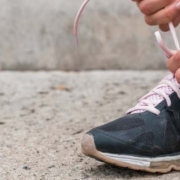Picking The Right Sneaker

by Paula Allia PT, DHSc, MTC, OCS
New Year’s resolutions are here! After the holidays each of us regroup. We think about what we are thankful for at Thanksgiving. Through Hanukkah and Christmas, we continue with family and friends on an eating and drinking fiesta. It seems that people find comfort in allowing themselves to break all of the rules and indulge.
Now, the time has come to lace up those sneakers and get serious about some sort of exercise. Many people buy sneakers based on the color. Others purchase because a friend told them to get them. Which sneaker should you buy to exercise in? Does is really matter?
In 2020, there were over 22 billion pairs of shoes produced. A large percentage of these shoes were athletic footwear with over 14 billion dollars in annual sales reported in June, 2021. There are plenty of athletic footwear companies that produce shoes today. In fact, there are at least 17 well-known companies that capitalize on the market. It is such a huge market that some regular shoe companies have now added them to their lineup.
As a shopper, it can be very confusing. What are the important characteristics of a pair of sneakers that make you want to buy them? Shoes should be specific to the individual. It is extremely important to identify the:
- Shape of the foot
- Arch of the foot•
- Coordination of the forefoot, midfoot, and hindfoot to work together
- The gait of the person
The fit of a shoe depends upon the shoe “last”. This “last”represents some of the anatomical positioning of the foot. The common types of lasts are the straight, semi-curved, and curve. This represents the shape of a specific foot. One way that you can find out which type you have is to get your feet wet then stand on something that you can see your imprint on the ground. This will determine the last angle that you have.
Wearing a curve lasted sneaker with a straight lasted foot is not ideal for you. This MUST be a consideration when shopping for the perfect sneaker.
Next, the arch of the foot is extremely important. Essentially there are three main arches, pronation, normal, and supination. Then there are variations to these. This arch is formed from the surrounding joints and tissue. Over years, sometimes the arch changes. It is not uncommon that the arch drops more toward the pronated foot and ultimately toward a flat foot as one ages.
When buying a sneaker, one should know at the very minimum what type of arch they have. The idea is that with both feet on the ground your foot position provides a stable base on which to not only stand but to perform all of your activities in.
Sneakers need to support your specific arch. Certain models support the normal arch and allow the foot to propel you forward while letting your foot react and transition from the hindfoot (rear of the foot) to the midfoot where the arch is and then to the forefoot (front of the foot).
Other shoes need to provide some support and try and guide your foot through the transitions when walking or running. This amount of support varies depending upon on the foot type.
Foot evaluations and gait analysis are extremely helpful when it comes to buying sneakers. When in the sneaker your foot can be observed through the step and stride length that you exhibit.
Finding the right shoes that help to correct a deficient gait can provide a smooth transition from one phase of gait to the next.
The construction of athletic shoes varies tremendously. Different materials are made to support the foot and allow for smooth transitions. Some are made specifically for a certain sport. All should have the common denominator of support to the arch with the proper last. If this is not present, the foot will have to absorb the pressures of a specific gait. Over time, the foot can breakdown leading to discomfort and ultimately dysfunction.
Discover your foot type and support the needs of the foot. Whether standing, walking, running, or otherwise, proper support should be comforting to your foot and may even correct other dysfunctions up through the leg.
Remember, when the foot hits the ground, the adaptation that occurs at the feet is pertinent to the longevity of your desired activities. Be smart. Educate yourself. If problems exist, consider getting orthotics to work with the proper shoe. Overcorrection can occur if you use an orthotic in the wrong shoes.
Here’s To Your Health!




Leave a Reply
Want to join the discussion?Feel free to contribute!